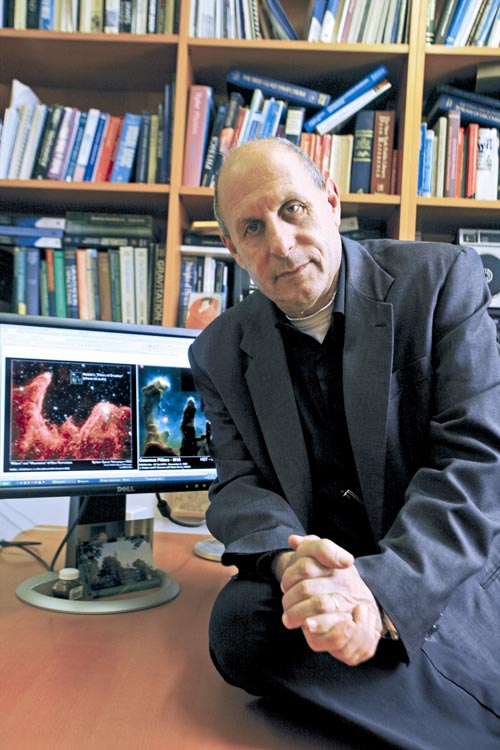Confirming Einstein, Scientists Find 'Spacetime Foam' Not Slowing Down Photons from Far-Away Gamma Ray Burst

Prof. Tsvi Piran, the Schwartzmann University Chair at the Hebrew University’s Racah Institute of Physics (Photo by Sasson Tiram for Hebrew University)
The researchers analyzed data, obtained by NASA's Fermi Gamma-ray Space Telescope, of the arrival times of photons from a distant Gamma-Ray Burst. The data showed that photons traveling for billions of years from the distant burst toward Earth all arrived within a fraction of a second of each other.
This finding indicates that the photons all moved at the same speed, even though different photons had different energies. This is one of the best measurements ever of the independence of the speed of light from the energy of the light particles.
Beyond confirming the General Theory of Relativity, the observation rules out one of the interesting ideas concerning the unification of General Relativity and Quantum Theory. While these two theories are the pillars of physics today, they are still inconsistent and there is an intrinsic contradiction between the two that is partially based on Heisenberg’s Uncertainty Principle that is at the heart of Quantum Theory.
One of the attempts to reconcile the two theories is the idea of “space-time foam.” According to this concept, on a microscopic scale space is not continuous, and instead it has a foam-like structure. The size of these foam elements is so tiny that it is difficult to imagine and is at present impossible to measure directly. However light particles that are traveling within this foam will be affected by the foamy structure, and this will cause them to propagate at slightly different speeds depending on their energy.
Yet this experiment shows otherwise. The fact that all the photons with different energies arrived with no time delay relative to each other indicates that such a foamy structure, if it exists at all, has a much smaller size than previously expected.
“When we began our analysis, we didn’t expect to obtain such a precise measurement,” said Prof. Tsvi Piran, the Schwartzmann University Chair at the Hebrew University’s Racah Institute of Physics and a leader of the research. “This new limit is at the level expected from quantum gravity theories and can direct us how to combine Quantum Theory and Relativity.”
The research paper, 'A Planck-scale limit on spacetime fuzziness and stochastic Lorentz invariance violation,' appears on the Nature Physics website (DOI 10.1038/nphys3270).
This research was supported by an ERC advanced grant; the I-CORE Israeli Centers Of Research Excellence; the Israel Space Agency; the joint Israel Science Foundation (ISF) and the National Natural Science Foundation of China (NSFC) program; and the Templeton Foundation.
Albert Einstein was a founder of the Hebrew University of Jerusalem. He bequeathed his writings, intellectual heritage and the rights to his image to the Hebrew University.
For information, contact:
Dov Smith
Hebrew University Foreign Press Liaison
+972-2-5882844 / +972-54-8820860
dovs@savion.huji.ac.il
Media Contact
All latest news from the category: Physics and Astronomy
This area deals with the fundamental laws and building blocks of nature and how they interact, the properties and the behavior of matter, and research into space and time and their structures.
innovations-report provides in-depth reports and articles on subjects such as astrophysics, laser technologies, nuclear, quantum, particle and solid-state physics, nanotechnologies, planetary research and findings (Mars, Venus) and developments related to the Hubble Telescope.
Newest articles

NASA: Mystery of life’s handedness deepens
The mystery of why life uses molecules with specific orientations has deepened with a NASA-funded discovery that RNA — a key molecule thought to have potentially held the instructions for…

What are the effects of historic lithium mining on water quality?
Study reveals low levels of common contaminants but high levels of other elements in waters associated with an abandoned lithium mine. Lithium ore and mining waste from a historic lithium…

Quantum-inspired design boosts efficiency of heat-to-electricity conversion
Rice engineers take unconventional route to improving thermophotovoltaic systems. Researchers at Rice University have found a new way to improve a key element of thermophotovoltaic (TPV) systems, which convert heat…



